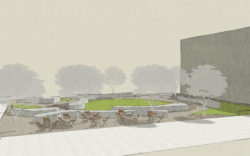Athens-Clarke County will get its first “roundabout” intersection as a result of flooding problems in the Cedar Creek subdivision. Heavy rains have been flooding yards near Ponderosa Drive and Sunnybrook Drive—just off Gaines School Road—and have eroded the banks of nearby Cedar Creek. Money from a local one-cent sales tax is available to fix such problems, but the county’s proposal to rework the intersection with “rain gardens” (grassed areas designed to function as shallow holding ponds) would have required the relocation of a homeowner’s driveway. So, planners came up with another idea: instead of a conventional T-shaped intersection, why not a roundabout, a traffic circle with rain gardens in its center?
Roundabouts are widely used in Europe in place of stoplights; because cars never stop moving (but continue around the circle until their ‘exit’ comes up), they handle traffic efficiently and safely. But—also because traffic never stops—they present more problems to pedestrians, ACC Transportation Director David Clark told county commissioners in a memo. Plus, “the design may be challenging for some drivers to navigate at first,” he wrote.
Clark’s recommendation was actually for a more conventional intersection design (because it would allow more rainwater to be absorbed). But Cedar Creek residents who spoke at last week’s commission meeting mostly liked the roundabout, despite their concerns about how pedestrians would get through or around the 100-foot circle. “There are a lot of walkers. We’re known as a walking community,” said Marie Mullan, who favors the roundabout.
“I just think this roundabout is not going to be very safe for those who walk and ride bicycles,” said Ann Berrigan, who doesn’t.
People often drive too fast through the subdivision, which has no sidewalks, and “having to negotiate the roundabout will certainly slow that traffic down,” Commissioner Andy Herod said. “Particularly on safety measures, the roundabout is superior to a traditional T-intersection.” Commissioners approved the single-lane roundabout design unanimously; it could be completed in the fall.
Another single-lane roundabout could also be built at the intersection of Tallassee and Whitehead Roads; citizens who attended a recent hearing on a redesign of that intersection tended to favor a traditional traffic light, but Buck Bacon of ACC’s Department of Transportation and Public Works says that a roundabout would be both cheaper and safer. Roundabouts reduce accident injuries by 75 percent, Bacon told Flagpole.
Also last week, commissioners blinked at approving construction of a new intown park/trail, the Pulaski Creek Greenway. Approved by voters in 2004, it would follow Pulaski Creek through a mostly undeveloped or industrial area parallel to the residential portion of Pulaski Street and behind the Council on Aging. But plans have been scaled back because the railroad that owns some of the property that the county needs to build the trail won’t sell. That reduces the length of the creekside trail by half, to about a third of a mile.
The sales-tax funded project was budgeted at $984,000, and was supposed to connect to College Avenue and the existing Oconee Rivers Greenway, which is routed nearby. But without several more acres of land at the Cleveland Avenue end of the creek—which Norfolk Southern railway has declined to sell to the county—the trail will run only 1000 feet along the creek, and another 500 or so to connect to Pulaski Street across from the Leathers Building (it would connect to Hoyt Street and the Council on Aging at the other end).
The reduced connectivity of the downsized plan has raised concerns with the Oconee Rivers Greenway Commission and, apparently, with ACC commissioners, who voted unanimously last week to defer a decision on going ahead with construction.
In a letter to Mayor Nancy Denson and commissioners, Greenway Commission Chair Ron Thomas said the new trail should either be cancelled—and the money spent instead on the proposed rail-trail east of downtown—or deferred until the missing land can be acquired. The scaled-back project “provides inadequate connectivity to the Greenway, the central reason for the project in the first place,” Thomas wrote, and would use up all the available money without acquiring the additional land.
Commissioner Kathy Hoard told Flagpole that members of the ACC SPLOST Oversight Committee have also expressed “concerns about the evolution of this project.” She asked to defer a decision for 30 days “to ensure that all possible resources have been exhausted to secure the necessary rights-of-way,” she said.
Voter-approved SPLOST projects are supposed to be built according to the original project description if at all possible. The Pulaski Creek project description mentions “links” to eight destinations—the greenway, Lyndon House Arts Center, the Council on Aging and several neighborhoods and residential complexes—several of which were based on having trail access through College Avenue. If commissioners do approve construction, the shortened trail will include benches, boardwalk bridges and perhaps a community garden, and could be finished by early 2013.
Like what you just read? Support Flagpole by making a donation today. Every dollar you give helps fund our ongoing mission to provide Athens with quality, independent journalism.










